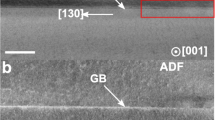Abstract
The segregation effect of B on the [100](010) edge dislocation core in NiAl single crystals is investigated using the DMol method and the discrete variational method within the framework of density functional theory. The impurity segregation energy and the charge distribution are calculated. The effects of B on the dislocation motion are discussed. The results show that B prefers to segregate at the Center-Al dislocation core. Moreover, B forms strong bonding states with its neighboring host atoms, which may not be beneficial to the motion of the dislocation. Therefore, it can be expected that the strength of NiAl single crystals may be increased.
Similar content being viewed by others
References
Noebe R D, Bowman R R, Nathal M V. Physical Metallurgy and Processing of Tntermetallic Compounds. Stoloff N S, Sikka V K, eds. New York: Chapman & Hall, 1996. 212
Ball A, Smallman R E. The deformation properties and electron microscopy studies of the intermetallic compound NiAl. Acta Metall, 1966, 14: 1349–1355
Takasugi T, Kishino J, Hanada S. Anomalous elongation behavior of stoichiometric NiAl single crystals at intermediate temperature. Acta Metall Mater, 1993, 41: 1009–1020
Yang C. Study of anomalous hardening in NiAl single crystals at intermediate temperature by FEA. Int J Mech Sci, 2006, 48: 950–957
Ghosh B, Crimp M A. Study of dislocations in NiAl through the use of in-situ straining in transmission electron microscopy. Mater Sci Eng A, 1997, 239–240: 142–149
Ebrahimi F, Shrivastava S. Brittle-to-ductile transition in NiAl single crystal. Acta Mater, 1998, 46: 1493–1502
Pollock T M, Lu D C, Shi X, et al. A comparative analysis of low temperature deformation in B2 aluminides. Mater Sci Eng A, 2001, 317: 241–248
Kontsevoi O Y, Gornostyrev Y N, Mryasov O N, et al. Electron localization on dislocation in metals: Real-space first-principles calculations. Phys Rev B, 2001, 64: 134103–134114
Fu C L, Zou J. Site preference of ternary alloying additions in FeAl and NiAl by first-principles calculations. Acta Mater, 1996, 44: 1471–1478
Liu C T, Horton J J A. Effect of refractory alloying additions on mechanical properties of near-stoichiometric NiAl. Mater Sci Eng A, 1995, 192–193: 170–178
Kong C H, Munroe P R. Microstructural characterisation of FeAl-Based alloys with small vanadium additions. Scripta Metall Mater, 1995, 32: 469–474
Medvedeva N I, Gornostyrev Y N, Novikov D L, et al. Ternary site preference energies, size misfits and solid solution hardening in NiAl and FeAl. Acta Mater, 1998, 46: 3433–3442
Wang Y L, Jones I P, Smallman R E. The effect of iron on the creep properties of NiAl. Intermetallics, 2006, 14: 800–810
Kontsevoi O Y, Gornostyrev Y N, Freeman A J, et al. Electronic mechanism of impurity-dislocation interactions in intermetallics: NiAl. Philos Mag Lett, 2001, 81: 455–463
Wang F H, Wang C Y, Yang J L. The effect of boron on the electronic structure of grain boundaries in Ni3Al. J Phys-Condens Matter, 1996, 8: 5527–5534
Feng Y Q, Wang C Y. Electronic effects of light impurities on edge dislocation motion in iron at T = 0 K. J Alloys Compounds, 2000, 312: 219–227
Dargusch M S, Bermingham M J, McDonald S D, et al. Effects of boron on microstructure in cast zirconium alloys. Mater Res Society, 2010, 25: 1695–1700
Miracle D B. Overview No. 104. The physical and mechanical properties of NiAl. Acta Metall Mater, 1993, 4: 649–684
Delley B. Analytic energy derivatives in the numerical local-density-functional approach. J Chem Phys, 1991, 94: 7245–7250
Delley B. An all-electron numerical method for solving the local density functional for polyatomic molecules. J Chem Phys, 1990, 92: 508–517
Ellis D E, Painter G S. Discrete variational method for the energy-band-problem with general crystal potentials. Phys Rev B, 1970, 2: 2887–2898
Guenzburger D, Ellis D E. Magnetism of Fe impurities in alkaline-earth-metals and Al. Phys Rev B, 1992, 46: 285–294
Vosko S H, Wilk L, Nusair M. Accurate spin-dependent electron liquid correlation energies for local spin density calculations: A critical analysis. Can J Phys, 1980, 58: 1200–1211
Duesbery M S. Dislocation in Solids. Amsterdam: Elsevier, 1989. 8: 76
Voter A F, Chen S P. High temperature ordered intermetallic alloys. In: MRS Symposia Proceeding No. 82. Siegel R W, ed. Pittsburgh: Materials Research Society, 1987. 175
Yan J A, Wang C Y, Duan W H, et al. Electronic states and doping effect of carbon in the edge-dislocation core of bcc iron. Phys Rev B, 2004, 69: 214110–214118
Mülliken R S. Electronic population analysis on LCAO-MO molecular wave functions. J Chem Phys, 1955, 23: 1833–1840
Author information
Authors and Affiliations
Corresponding author
Rights and permissions
About this article
Cite this article
Chen, L., Yu, T. The effect of boron on the electronic structure of dislocation in NiAl. Sci. China Phys. Mech. Astron. 54, 815–820 (2011). https://doi.org/10.1007/s11433-011-4324-y
Received:
Accepted:
Published:
Issue Date:
DOI: https://doi.org/10.1007/s11433-011-4324-y




